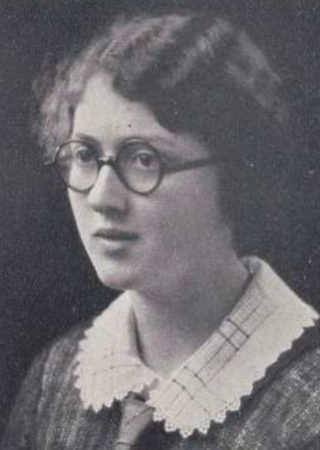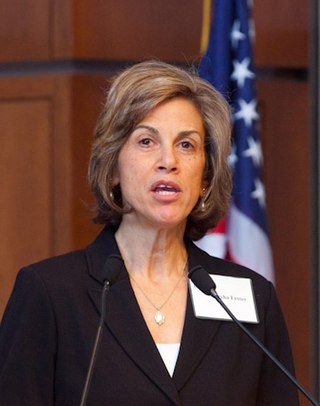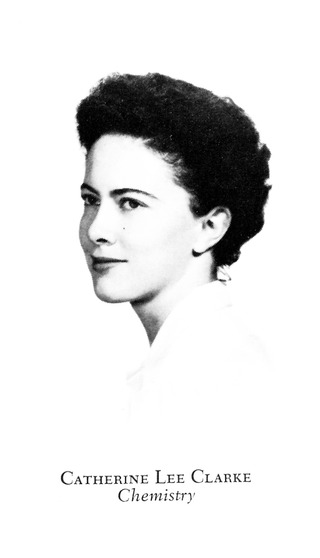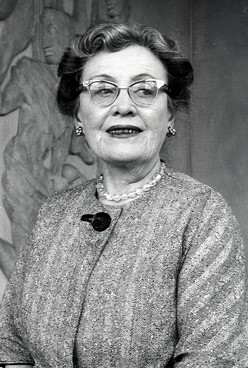Related Research Articles

Jacqueline K. Barton, is an American chemist. She worked as a professor of chemistry at Hunter College (1980–82), and at Columbia University (1983–89) before joining the California Institute of Technology. In 1997 she became the Arthur and Marian Hanisch Memorial Professor of Chemistry and from 2009 to 2019, the Norman Davidson Leadership Chair of the Division of Chemistry and Chemical Engineering at Caltech. She currently is the John G. Kirkwood and Arthur A. Noyes Professor of Chemistry.

Lucy Weston Pickett was a Mary Lyon Professor and Camille and Henry Dreyfus Chair in Chemistry at Mount Holyoke College.

Anna Jane Harrison was an American organic chemist and a professor of chemistry at Mount Holyoke College for nearly forty years. She was the first female president of the American Chemical Society, and the recipient of twenty honorary degrees. She was nationally known for her teaching and was active nationally and internationally as a supporter of women in science.

Mildred Cohn was an American biochemist who furthered understanding of biochemical processes through her study of chemical reactions within animal cells. She was a pioneer in the use of nuclear magnetic resonance for studying enzyme reactions, particularly reactions of adenosine triphosphate (ATP).

Mary Lowe Good was an American inorganic chemist who worked academically, in industrial research and in government. Good contributed to the understanding of catalysts such as ruthenium which activate or speed up chemical reactions.
Fred Basolo was an American inorganic chemist. He received his Ph.D. at the University of Illinois at Urbana-Champaign in 1943, under Prof. John C. Bailar, Jr. Basolo spent his professional career at Northwestern University. He was a prolific contributor to the fields of coordination chemistry, organometallic, and bioinorganic chemistry, publishing over 400 papers. He supervised many Ph.D. students. With colleague Ralph Pearson, he co-authored the influential monograph "Mechanisms of Inorganic Reactions", which illuminated the importance of mechanisms involving coordination compounds. This work, which integrated concepts from ligand field theory and physical organic chemistry, signaled a shift from a highly descriptive nature of coordination chemistry to a more quantitative science.
Mary Letitia Caldwell was an American chemist. Growing up she valued education and strived to achieve. She was an instructor at Western College teaching chemistry. She was known for being unique and descriptive along with being family orientated. Maria was in a wheel chair due to muscular disability. Most of her work centered on amylase, a starch enzyme, most notably finding a method for purifying crystalline porcine pancreatic amylase. She spent sixty years doing this.

Sarah Ratner was an American biochemist. Her contributions to the study of nitrogen metabolism led to a better understanding of human disorders in urea synthesis. In 1961, Ratner was awarded the Garvan–Olin Medal from the American Chemical Society and was elected to the National Academy of Sciences in 1974.

Marsha Isack Lester is an American physical chemist. She is currently the Edmund J. Kahn Distinguished Professor of Chemistry at the University of Pennsylvania. Lester uses both theoretical and experimental methods to study the physical chemistry of volatile organic compounds present in the earth's atmosphere. Her current work focuses on the hydroxyl radical and Criegee intermediates.
Icie Gertrude Macy Hoobler was an American biochemist who did research in human nutrition, specifically pertaining to mothers and children. Despite facing discrimination because of her gender, she became the first woman chair of a local section of the American Chemical Society and won 22 awards and honors for her laboratory's research.

Catherine Clarke Fenselau is an American scientist who was the first trained mass spectrometrist on the faculty of an American medical school; she joined Johns Hopkins School of Medicine in 1968. She specializes in biomedical applications of mass spectrometry. She has been recognized as an outstanding scientist in the field of bioanalytical chemistry because of her work using mass spectrometry to study biomolecules.
Sofia S. "Topsy" Simmonds was an American biochemist who studied amino acid metabolism and peptide metabolism in E. coli. Following training with Vincent du Vigneaud at Cornell University, she spent most of her career at Yale University. After decades as a researcher and then associate professor there, Simmonds became a full professor of biochemistry in 1975, and later served as Associate Dean of Yale College. With her husband Joseph Fruton, Simmonds coauthored the influential General Biochemistry, the first comprehensive biochemistry textbook. Simmonds received the American Chemical Society's Garvan Medal in 1969.
Grace Medes was an American biochemist, who discovered tyrosinosis—a metabolic disorder today known as tyrosinemia—and studied fatty acid metabolism. She was awarded the Garvan-Olin Medal in 1955 for her work.
Jean'ne Marie Shreeve is an American chemist known for her studies of fluorine compounds and explosives. She has held her namesake professorship at the University of Idaho since 2004.

Agnes Fay Morgan was an American chemist and academic. She was the longtime chair of the home economics program at the University of California. Her program was strongly grounded in science, and students admitted into the program were required to have a level of science education that was not typical of home economics programs at the time. Morgan was one of the earliest married female college professors in the United States.
Sherry J. Yennello is an American nuclear chemist and an Elected Fellow of the American Association for the Advancement of Science. She is a Regents Professor and the holder of the Cyclotron Institute Bright Chair in Nuclear Science, who currently serves as the Director of the Cyclotron Institute at Texas A&M University. She is also a Fellow of the American Chemical Society and the American Physical Society. She has authored as well as co-authored more than 530 peer reviewed journal articles and has conducted many invited talks, presentations and seminars at several prestigious academic conferences and scholarly lectures.
Sara Jane Rhoads was an American chemist. She was one of the first women in the United States to become a full professor of chemistry, helped to establish the chemistry department at the University of Wyoming, and was the recipient of the American Chemical Society's Garvan–Olin Medal in 1982.
Janet Gretchen Osteryoung was an American chemist who was the director of the Chemistry Division of the National Science Foundation from 1994 to 2001. Her research furthered the development of electroanalysis and especially that of square wave voltammetry. She was elected a Fellow of the American Association for the Advancement of Science in 1984 and awarded the Garvan–Olin Medal in 1987.

John W. Birks is an American atmospheric chemist and entrepreneur who is best known for co-discovery with Paul Crutzen of the potential atmospheric effects of nuclear war known as nuclear winter. His most recent awards include the 2019 Haagen-Smit Clean Air Award for his contributions to atmospheric chemistry and the 2022 Future of Life Award for discovery of the nuclear winter effect.
Kathlyn Ann Parker is a chemist known for her work on synthesis of compounds, especially organic compounds with biological roles. She is an elected fellow of the American Chemical Society and a recipient of the Garvan–Olin Medal in chemistry.
References
- 1 2 3 Nightingale, Dorothy Virginia (1975). A history of the Department of Chemistry, University of Missouri-Columbia, 1843-1975.
- ↑ "American Chemical Society Garvan Award Medal Dorothy V. Nightingale". Chemical and Engineering News. April 20, 1959.
- ↑ Oakes, Elizabeth (2002). International Encyclopedia of Women Scientists. New York, NY: Facts on File, Inc. pp. 265–266. ISBN 0-8160-4381-7.
- 1 2 3 4 Marilyn Bailey Ogilvie; Joy Dorothy Harvey (2000). The Biographical Dictionary of Women in Science: L-Z. Taylor & Francis. p. 944. ISBN 9780415920384 . Retrieved 12 November 2016.
- ↑ Wayne, Tiffany (2011). American Women of Science Since 1900, Volume 1. ABC-CLIO. p. 719. ISBN 978-1-59884-158-9 . Retrieved 12 November 2016.